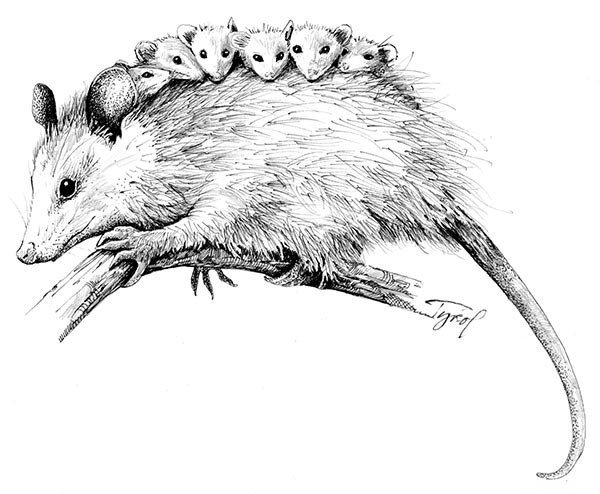
On our back porch, in a pocket of light from the window, was what looked to be an oversized rat wearing white face powder. As it gobbled down cat food, it flashed a demented crocodile grin. My mother shrieked.
This was my first encounter with a Virginia opossum.
This species, still described as “neotropical” by some sources, has been moving north since at least the 1950’s. In many parts of the northeast, opossums (frequently shortened to “possums”) are as familiar as squirrels. Yet this is no mere rodent.
Possums are the only marsupials native to North America. Despite appearances, they are closer kin to wombats and kangaroos than rats or Kiss bassist Gene Simmons. Marsupials branched off of the main mammalian family tree long ago, and many of the traits they exhibit offer a window into what ancient mammals were like. Many of these differences relate to reproduction. All marsupials have pouches. They need these because they are not, like most mammals, placental. Their young spend barely any time developing in the mother’s body. They’re born in a near-fetal state, and the tiny, naked and blind young must make a scramble to the pouch where they can complete their development in relative safety.
Newborn possums are born only the size of honeybees, and many don’t survive the trip to their mother’s pouch. Those that do must locate one of thirteen nipples, arrayed in a circle with one in the middle. As soon as a baby possum starts to suckle, the nipple swells in its mouth, effectively trapping it in place until it has grown big enough to free itself. Once out of the pouch, the baby possum, along with its littermates, will hitch a ride by clinging to its mother’s back.
Females can have as few as four or as many as 25 offspring at a time, of which about eight make it to the pouch. It only takes the young ten months to reach sexual maturity, and in warmer climates with longer summers, possums can have up to three litters per year.
Easily the possum’s most significant contribution to popular culture is the phrase “playing possum” - but when it comes to feigning death, the possum is anything but playing. Under most circumstances, a threatened possum will bear its (surprisingly large) teeth with a hiss or screech. However, faced with a dire enough threat, it up and “dies.”
It drops into a near-coma. Its tongue lolls, eyes open but vacant, and a foul green liquid leaks from its anus. It may take a possum upwards of four hours to come out of this apparently involuntary biochemical state.
It’s perhaps little wonder that the possum should be so good at imitating death, because death lurks around every corner for this species. Due to heavy predation, and a predilection for becoming road kill, possums typically live only a measly two years in the wild, and even those living in captivity succumb to old age quickly.
And this death rate is despite a few startling immunities. Possums are highly resistant to pit viper (e.g. copperhead, water moccasin) venoms. Research suggests that possums—which will eat snakes, among many other things—are locked in an evolutionary arms race where they are constantly developing new ways to combat snake venom. They’re highly resistant to rabies, likely as a result of a slightly lower body temperature that makes it difficult for the virus to thrive.
They also function as tick vacuums. A possum trundling through the undergrowth accumulates a large collection of ticks, but possums are such fastidious groomers that ticks which latch onto them are as good as dead. A dense possum population may even help reduce the prevalence of Lyme disease.
The possum is a consummate opportunist, exactly the sort of middleweight scavenger that thrives in the margins of human society. By all accounts, it is doing well: despite a near-total lack of real winter survival skills, it can be found as far north as Southern Ontario. Global warming and the ceaseless march of human development only serve to prime the possum for further range expansion in the near future.
All things considered, the possum may not be the worst hanger-on for humanity to have. It provides a lesson in the extraordinary-as-ordinary. It’s easy to disregard the sheer, magnificent oddity of this omnivore, but truth is stranger than fiction, and few truths are stranger than the Virginia opossum.


Discussion *